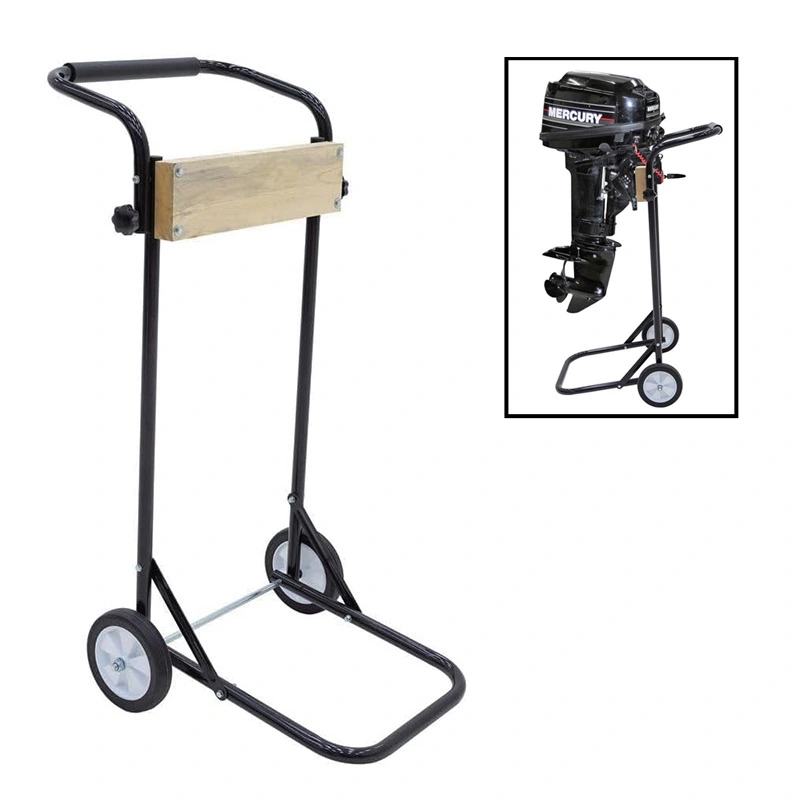Essential Safety Features of Outboard Motor Carts
Weight Capacity and Load Distribution
One of the paramount safety considerations for outboard motor carts is their weight capacity. Manufacturers design these carts to support specific load ranges, and exceeding these limits can lead to structural failure or instability. It's imperative to choose a cart that can comfortably accommodate the weight of your outboard motor. Additionally, proper load distribution is crucial for maintaining balance and preventing tipping. Center the motor on the cart, ensuring that the weight is evenly distributed across the support points. This practice not only enhances safety but also prolongs the life of both the cart and the motor.
Locking Mechanisms and Secure Attachment Points
High-quality outboard motor dollies feature robust locking mechanisms to prevent accidental movement during transport or storage. These may include wheel locks, swivel locks, or specialized braking systems. Secure attachment points are equally important, allowing you to firmly fasten the motor to the boat motor cart. Look for carts with adjustable straps, clamps, or brackets that can accommodate various motor sizes and shapes. These features work in tandem to ensure that your valuable equipment remains stable and secure, even when navigating uneven terrain or during sudden stops.
Corrosion-Resistant Materials and Construction
Given the marine environment in which outboard motor carts operate, corrosion resistance is a critical safety feature. Exposure to saltwater, humidity, and other corrosive elements can quickly degrade subpar materials, compromising the cart's structural integrity. Opt for carts constructed from marine-grade stainless steel, aluminum, or high-density polyethylene (HDPE). These materials not only resist rust and corrosion but also maintain their strength and reliability over time. A well-built, corrosion-resistant cart ensures consistent performance and reduces the risk of unexpected failures that could lead to accidents or damage to your outboard motor.
Proper Usage and Maintenance Techniques
Correct Loading and Unloading Procedures
Mastering the art of safely loading and unloading an outboard motor onto a boat motor cart is fundamental to preventing injuries and equipment damage. Begin by positioning the cart on a level surface, engaging all locking mechanisms to ensure stability. When lifting the motor, use proper ergonomic techniques, bending at the knees and keeping your back straight. If the motor is particularly heavy, enlist the help of a colleague or use a mechanical lift. Slowly lower the motor onto the cart, aligning it with the designated support points. Once in place, secure the motor using the cart's attachment systems, double-checking that all fasteners are tight and correctly positioned.
Regular Inspection and Maintenance Routines
Consistent inspection and maintenance of your outboard motor dolly are crucial for long-term safety and reliability. Establish a regular schedule to check all components, including wheels, axles, support structures, and locking mechanisms. Look for signs of wear, corrosion, or damage that could compromise the cart's integrity. Pay special attention to load-bearing parts and moving components, applying lubricant where necessary to ensure smooth operation. Replace any worn or damaged parts promptly, using only manufacturer-approved replacements to maintain the cart's safety standards. By implementing a proactive maintenance routine, you can identify potential issues before they escalate into safety hazards.
Proper Storage and Environmental Considerations
The way you store your outboard motor cart when not in use can significantly impact its safety and longevity. Ideally, store the cart in a dry, covered area to protect it from the elements. If outdoor storage is unavoidable, consider using a weatherproof cover to shield it from rain, UV rays, and other environmental factors. Before each use, inspect the cart for any signs of pest infestation or environmental damage. In coastal areas, be particularly vigilant about saltwater exposure, rinsing the cart with fresh water after use near the ocean. By taking these precautions, you ensure that your cart remains in optimal condition, ready to safely transport your outboard motor whenever needed.
Compliance with Industry Standards and Regulations
Understanding Relevant Safety Certifications
Navigating the world of safety certifications for outboard motor carts can be complex, but it's essential for ensuring you're using equipment that meets recognized standards. Look for carts that comply with ISO (International Organization for Standardization) guidelines, particularly those related to material quality and load-bearing capacity. In the United States, certifications from organizations like ANSI (American National Standards Institute) or ASTM (American Society for Testing and Materials) can provide additional assurance of quality and safety. These certifications often cover aspects such as structural integrity, stability under load, and resistance to environmental factors. By choosing a certified cart, you're investing in a product that has undergone rigorous testing and meets industry-accepted safety benchmarks.
Staying Updated on Regulatory Changes
The landscape of safety regulations for marine equipment, including outboard motor dollies, is not static. Regulatory bodies periodically update their guidelines to reflect new technologies, emerging risks, or improved safety practices. As a responsible user, it's crucial to stay informed about these changes. Subscribe to industry publications, follow relevant regulatory agencies on social media, or join professional marine associations to receive timely updates. Manufacturers often communicate important regulatory changes to their customers, so ensure you're registered for product updates if available. By staying abreast of the latest regulations, you can make informed decisions about upgrading or modifying your equipment to maintain compliance and optimal safety standards.
Importance of Documentation and Training
Proper documentation and training are often overlooked aspects of safety compliance for outboard motor carts. Maintain a comprehensive record of your cart's specifications, maintenance history, and any modifications. This documentation can be invaluable for troubleshooting issues, planning maintenance, or demonstrating compliance during inspections. Equally important is ensuring that all users are adequately trained in the safe operation of the cart. This includes understanding weight limits, proper loading techniques, and emergency procedures. Consider implementing a formal training program for new users, complete with hands-on practice sessions. By prioritizing documentation and training, you create a culture of safety that extends beyond mere equipment specifications, encompassing the human element crucial for preventing accidents and ensuring optimal use of your outboard motor cart.
Conclusion
Understanding and adhering to safety standards for outboard motor carts is paramount for anyone involved in marine operations. By focusing on essential safety features, implementing proper usage and maintenance techniques, and staying compliant with industry standards, you can significantly reduce risks associated with handling outboard motors. Remember, safety is not just about following rules; it's about creating a culture of responsibility and awareness. By prioritizing these safety aspects, you not only protect your valuable equipment but also ensure the well-being of everyone involved in marine activities. Embrace these standards as a foundation for safe and efficient operations in your marine endeavors.
Contact Us
For more information about our high-quality outboard motor carts and other marine equipment, please contact us at info@runva.com.cn. Our team of experts is ready to assist you in finding the perfect solution for your needs while ensuring the highest safety standards.

_1737625693698.webp)


